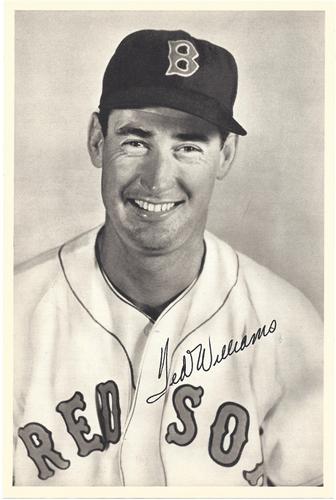July 29, 1955: Ted Williams’s solo home run in the first inning proves a game-winner for Red Sox
 Not often does a solo home run in the first inning turn out to the game-winning hit in a ballgame,1 but those were the circumstances of Ted Williams’s 383rd career homer, which won this game between the Boston Red Sox and Detroit Tigers.
Not often does a solo home run in the first inning turn out to the game-winning hit in a ballgame,1 but those were the circumstances of Ted Williams’s 383rd career homer, which won this game between the Boston Red Sox and Detroit Tigers.
Over the course of his career, Williams hit 16 first-inning home runs that wound up winning a game. This one, and his pennant-clinching inside-the-park home run off Red Embree of Cleveland on September 13, 1946, were the only two that were solo-homer game-winners.
The pitcher for the Tigers was Jim Bunning, appearing in his third major-league game. The future Hall of Famer (and United States senator) was 1-1 at this point in his rookie year; his debut had been just nine days earlier.
The Red Sox were still in pennant contention, more than halfway through the season. They came into this game having gone 23-8 over the previous month. They were in fourth place, but only three games behind the first-place Chicago White Sox. The Tigers were in fifth place, only 2½ games behind the Red Sox.
The Tigers were visiting Fenway Park for this Friday night game, and thus first to bat. The starting pitcher for the Red Sox, in his sixth year with the team, was right-hander Willard Nixon. Shortstop Harvey Kuenn led off with a single to his counterpart at short, Billy Klaus, with the ball taking an unexpected hop and glancing off Klaus’s arm. Center fielder Bill Tuttle then grounded into a double play, to Klaus, who threw to second baseman Billy Goodman and on to Norm Zauchin at first base. Nixon struck out Tigers right fielder Al Kaline.
Bunning got groundouts from the first two batters he faced, Goodman and Klaus. Ted Williams came to bat, facing Bunning for the first time in his career. Williams hit a home run, “tight up the right-field line and well back into the stands.”2 It was 1-0, Red Sox. Next up was Jackie Jensen. Bunning struck him out looking.
Two fly balls and a pop fly saw the Tigers retired in the second inning. Bunning walked the first two Boston batters in the bottom of the inning but then got a fly ball and a double play.
Second baseman Harry Malmberg singled in the Detroit third. Billy Goodman doubled in the bottom of the third. No one else reached base for either side.
No one from either team reached base in the fourth inning. The score remained Boston 1, Detroit 0.
The Tigers went down one-two-three in the top of the fifth inning. The Red Sox added three runs in the bottom of the fifth. Grady Hatton led off with a single to right-center. Jimmy Piersall bunted toward third base for a single. Hatton ran all the way to third on a throwing error by third baseman Ray Boone. Nixon was up next and he singled, too, “a solid single through shortstop” driving in Hatton.3 Billy Goodman bunted to advance both baserunners; Bunning dropped the ball and Goodman was safe. The bases were loaded.
While Klaus was batting, Bunning thew a wild pitch and Piersall scored. Bunning then struck out Klaus. With first base open, the call was an obvious one – Williams was walked intentionally. Jensen grounded out to first base, unassisted (the ball bouncing off his bat as he tried to fall away from the plate). Nixon scored from third base for a 3-0 advantage.
Norm Zauchin walked, and the bases were loaded once more. Catcher Sammy White grounded to shortstop, for a force play at second base. The inning ended with Boston holding a 4-0 lead.
In the top of the sixth inning, Nixon induced groundouts from Malmberg, Bubba Phillips (pinch-hitting for Bunning), and Kuenn.
Paul Foytack took over pitching duties from Bunning and worked the bottom of the sixth. Piersall singled, the only batter to reach base, but was picked off first base. Nixon struck out.
Tuttle led off the seventh inning with a two-base hit. Three groundouts followed, one after the other. Tuttle had to hold at second base throughout.
With one out in the Red Sox seventh, Klaus singled to center. Williams hit a fly ball to deep right field, missing a homer run “by a few feet … Kaline making the catch in front of the Sox bull pen fence.”4 Jensen flied out to center.
Nixon faced the minimum three batters in the Tigers’ top of the eighth.
In the bottom of the eighth inning, Zauchin singled to left. White singled to center. Hatton grounded out to first base, unassisted, both baserunners moving up 90 feet. Piersall walked, which loaded the bases. Foytack struck out Nixon. Goodman walked, forcing in a fifth run. 5-0, Red Sox. Klaus struck out.
In the top of the ninth inning, Charlie Maxwell pinch-hit for Foytack. He flied out to left field. Kuenn grounded out, short to first. Bill Tuttle singled to center field, his second hit of the game. Al Kaline popped out to third base for the final out of them.
The 32,631 at a packed-out Fenway saw a superb performance by Willard Nixon, a 5-0 complete-game shutout, a four-hitter. He walked no one and struck out only one. No Tiger reached third base, and only two got to second base. Most of the outs were infield outs; only five outs were recorded by Red Sox outfielders.5 Nixon’s season record improved to 10-5. His career record against Detroit improved to 12-4.
Over the five years that followed, Williams hit seven more home runs off Jim Bunning.
What had been a cluster of five teams within six games of first place near the end of July saw both the Red Sox and Tigers finish fourth and fifth respectively, but Boston was 12 games behind the first-place Yankees and Detroit was 17 games behind.
Acknowledgments
This article was fact-checked by Mike Huber and copy-edited by Len Levin.
Photo credit: Ted Williams, Trading Card Database.
Sources
In addition to the sources cited in the Notes, the author consulted Baseball-Reference.com and Retrosheet.org.
https://www.baseball-reference.com/boxes/BOS/BOS195507290.shtml
https://www.retrosheet.org/boxesetc/1955/B07290BOS1955.htm
Notes
1 A “game-winning home run” is defined here as a home run that provides a game’s final margin of victory, giving the winning team at least one more run than the opposing team scored. For example, if a two-run homer increased a team’s lead from 2-1 to 4-1, and it went on to win 4-3, it qualifies as a game-winning home run. (This is different from the definition of “game-winning RBI” in baseball’s official statistics from 1980 through 1988, which counted as “game-winning” the RBI that provided a winning team the lead that it never relinquished.)
2 Henry McKenna, “Nixon, Williams Spark Sox 5-0 Win,” Boston Herald, July 30, 1955: 1, 5.
3 Bob Holbrook, “Nixon, Sox Halt Tigers, 5-0,” Boston Globe, July 30, 1955: 1, 4.
4 F.C. Matzek, “Red Sox Blank Tigers, 5-0,” Providence Journal, July 20, 1955: 1, 9.
5 One of the outfield putouts was by Ted Williams in the fifth inning, described by Matzek as “a spectacular back-handed and overhead stop of Boone’s drive to the left-field scoreboard.” The Boston Globe called it “a spectacular stab … going toward the wall full tilt.”
Additional Stats
Boston Red Sox 5
Detroit Tigers 0
Fenway Park
Boston, MA
Box Score + PBP:
Corrections? Additions?
If you can help us improve this game story, contact us.


